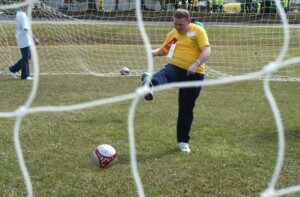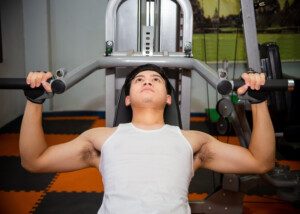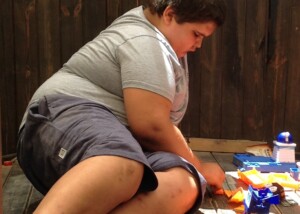Why do so many parents let their intellectually disabled kids lead an excessively sedentary life, causing significantly poor fitness and mobility problems?
Before I proceed, the qualifications of this topic are as follows.
- The child’s or adult’s IQ is high enough for them to follow exercise instructions.
- The child or adult does not have a condition that would severely restrict activity or mobility such as cerebral palsy or a congenital heart defect.
I’ve noted this phenomenon all my life: Parents don’t get their intellectually challenged kids into fitness.
In Special Olympics, participants even with very low cognitive levels can develop some fitness along the way, depending on the sport, their coach and other variables that affect training.
But to keep this article more focused, I’m going to confine the topic to those individuals with ID who, in adulthood, do not participate in a Special Olympics sport that by nature, would enhance one’s level of fitness and mobility – such as track events, basketball, soccer, flag football and team handball, among others.
As a part-time support community connector, I’ve recently begun working with “Jaymi,” who has an ID.
She’s 55 and quite overweight. She shuffles with a very short stride and can’t walk down four steps without hands-on support from someone.
We walked up a smooth asphalt incline of 10-12% leading to the library doors.
For the entire 60 feet or so, Jaymi shuffled at around 0.8 to 1 mph.
At the doors, Jaymi was visibly wiped, breathing hard. When she spoke it sounded like how a typical person would sound after running up three flights of stairs as fast as possible.
I know what you’re thinking: Jaymi gets a free pass for such abysmal physical condition because she’s 55.
You might also be thinking she gets a pass because she’s quite overweight, especially coupled with an ID.
There’s multiple factors wrong with making these allowances. Let’s begin with her weight.
Obesity, Fitness and Mobility
Based on my fitness and personal training background, Jaymi is around 250 at average height.
The only condition that she has, according to her profile, that would impact an exercise regimen is “back arthritis.”
The pain is managed with periodic epidural steroid injections.
Jaymi doesn’t report hip or knee pain; just a periodic upper leg pain that’s a radiating from the back issue.
This isn’t what makes her shuffle so slowly, nor was it responsible for leaving her heavily breathing after that 60 foot, very slow walk.
Being extremely out of shape at 250 pounds makes it difficult to walk, even very slowly, up a short grade.
The “out of shape” refers to very poor cardiovascular condition from an extremely sedentary lifestyle.
Her body simply did not know how to keep up with the oxygen demands of that short slow walk; this signifies a high level of deconditioning and impaired cardiorespiratory fitness.
We can’t say, though, that it’s “all because she’s morbidly obese.”
If we declare, “It’s because she’s so heavy,” then this blatantly contradicts the fact that morbidly obese people can improve their stamina and mobility if they stick to a cardio exercise program.
In fact, there are Instagram accounts devoted to physical activities including hiking that morbidly obese adults do.
The prior ID woman whom I was an SCC for also weighed 250 (5’6).
I’d take her to the gym where she’d average 3.7 mph on a treadmill at 5% incline for 15 minutes nonstop – without holding on.
She was 38 – but I can extrapolate that if she continues her treadmill workouts, plus her calisthenics, a few times a week, she’ll have nicely preserved mobility when she’s 55 — and have no issue walking that path to the library entrance.
Structured, consistent exercise is a wonder drug for preserving mobility and yielding stamina, even in obese individuals.
Age: Jaymi Is 55
Based on Jaymi’s current physical state, it’s not believable that when she was 38, her body was as functional as my previous client’s.
When I was a personal trainer I had a 55-year-old female client of typical cognition who weighed 250 (yes, I know that sounds so coincidental, but it’s true).
She had osteoarthritis in both knees and had a slightly side-to-side gait due to lack of exercise, age, obesity and the knee problems.
I put her on a treadmill, strength training and balance training program.
After eight weeks her gait was normal and smooth in appearance, and she reported being able to garden without pain afterwards and even keep up with her son on easy hikes.
Age 55 may seem old to young adults, but from a medical standpoint, it’s actually young. It’s considered middle age, not elderly.
There are scores of older people on Instagram who’ve documented fitness journeys that began in their 50s – with stunning results.
Quite bluntly, 55 is no excuse for Jaymi’s situation. Nor is her obesity.
Though if she weighed 150, I’m certain her mobility and stamina wouldn’t be as bad, but she’d still be in poor shape.
Intellectual Disability
Jaymi functions at a cognitive level that would not preclude her from taking exercise instruction.
If I were to place Jaymi on a treadmill, she’d walk on it. We’d have to start out at 1 mph, but we could increase the speed and nonstop time over ensuing weeks.
In a matter of months, she’d have a marked improvement in ambulation, gait and stamina.
But that’s never going to happen – not because of childlike cognitive skills; not because she’s fat; not because she’s middle age.
- It’s because her mother never instilled in her the importance of exercise.
- It’s because her sister, whom she lives with, is very sedentary herself.
- Her sister enables her and thinks it’s inevitable for Jaymi to be in such appalling physical shape because she has a cognitive disability.
I was at her home and got a pretty good idea of Jaymi’s lifestyle. She spends a lot of time in a recliner chair, legs propped up, watching TV. A recliner. That alone speaks volumes.
She has no assigned chores. Quite succinctly, Jaymi has been encouraged all her life to be a couch potato.
And this is the lifestyle that many parents are perfectly okay with for their ID kids. Perhaps they just don’t think they’re capable of structured exercise. WELL THEY ARE. See the inspiring video at the conclusion of this article!
Jaymi’s sister, who loves her dearly and gives her a supportive, safe home, will likely never see the light about how tremendously crucial it is to maintain fitness and mobility!
Just 30 minutes a day of dedicated, supervised workouts would make all the difference in the world.
Finding a half an hour a day to help a disabled loved-one with exercise should never be negotiable.
What’s going on with the parents?
- How can parents allow this to happen?
Jaymi’s sister is going to be devastated when she dies at a young age.
Walking speed and mobility are strongly predictive of all-cause mortality (premature death from any cause).
Furthermore, Jaymi will be using a cane soon; that’s how unstable she is.
She’ll be on a walker within five years, if not three.
How is her sister going to help a 250 pound woman in and out of cars and showers, off toilets, up from chairs, etc.?
It’s going to get worse and worse – decades before it actually has to.
Skeptics’ Objections
If you’re still convinced that Jaymi gets a pass due to a low IQ, then you should attend Special Olympics sports that require aerobic conditioning, swift ambulation and balance.
If someone is in dismal condition and is stiff and slow in movement, participation will make a big difference in their body function. Athletes are placed in divisions that align with their abilities.
Intellectual disability is no excuse for how Jaymi – and so many like her – has ended up. It’s appalling. It’s so sad. It’s inexcusable.
Jaymi and those with similar cognitive function do not need literacy or math skills to partake in a strength training program – with supervision.
Parents or caretaking family members just don’t want to put in the dedication, or, they have a delusion that low IQ = incapable of using a treadmill or doing leg strengthening exercises.
Though Jaymi’s back condition and abominably stiff hips (from chronic inactivity) would contraindicate certain strength training exercises such as full squats, there’s still plenty she can do to make her entire musculoskeletal system stronger, sturdier and more resilient, and her cardiovascular system a lot more efficient.
There’s still time. She’s only 55 (again, young from a medical standpoint) and does not (yet) require a mobility aid.
And by the way, Jaymi’s sister has the time to supervise her an hour a day (or two, 30 minute sessions) for exercise.
She gets paid by Medicaid to take care of her and hence, doesn’t work outside the home.
Making time for exercise should be of paramount importance to help Jaymi live a more physically independent life instead of being dependent on a scooter by the time she’s 60 or 62.
Just don’t go there: blaming “no time” on why parents and family caretakers don’t implement a supervised exercise regimen for their loved-ones with an intellectual disability.
![]()










































